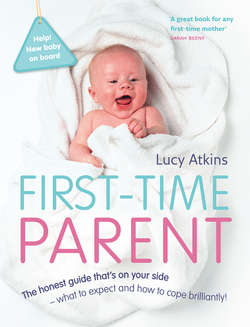Читать книгу First-Time Parent: The honest guide to coping brilliantly and staying sane in your baby’s first year - Lucy Atkins - Страница 22
THE APGAR SCORE DECODED
ОглавлениеACTIVITY/muscle tone: limp/ no response/active/taut arms and legs
PULSE/heart rate: absent to more than 100 beats per minute
GRIMACE: first breath response–none to sneeze or cough
APPEARANCE: colour–white/ blue/grey to pink all over
RESPIRATION: (absent to good/cry)
When your baby is only one minute old, the midwife or doctor will run down a quick ‘healthy signs’ checklist (in their head). They check your baby for five signs that she is healthy, and for each one they give her a score–anything from zero (bad) to two (the best possible). If, for instance, your baby has completely limp arms and legs, she’ll get zero for ‘Activity’. If she is moving a bit she’ll get a one, and if she’s actively wriggling–the healthiest sign in a newborn–she’ll get a two. This score helps them to assess how well she has coped with the birth, and whether she needs any medical attention. The most a baby can get is a ten, though it’s rare to get this at one minute. By five minutes, when the Apgar score is done again, most babies are a good solid ten.
How soon your baby will want a feed after the birth varies, but if you are both healthy, the midwife should help you to try your first breastfeed within about thirty minutes of giving birth.
After the birth you will usually stay put in your delivery suite for a couple of hours. If you tore or had an episiotomy, the midwife or doctor will stitch you up; she’ll also weigh your baby, and put two identity tags on each of her ankles. You should be offered the chance to pee, have a shower or wash. It’s absolutely fine to have a bath at any point after giving birth, but don’t make it too hot or you might faint–largely through exhaustion. Finally, after a couple of hours, when the midwife has done the paperwork, you have decided to name your baby after her and you are really, completely sure you’ve counted all those fingers and toes, you will be trundled on to the ward, usually in a wheelchair. You may be allowed to carry your baby in your arms as you go, or it may be the hospital’s policy to wheel your baby next to you in a Perspex cot (a see-through plastic box on trolley wheels that looks a bit like a prop in a 1960s B-movie). If the hospital insists on moving your baby in the cot and not in your arms, it is a health and safety thing: some units don’t want to be put in a tricky position by exhausted mummies dropping babies en route to the ward.
If you had a Caesarean, you will be taken from the operating theatre into a recovery room or observation area. How long you stay in recovery varies from hospital to hospital. In some, you stay there for twelve to twenty-four hours; in others, you’ll only be there for a couple of hours before being taken to the ward. But you’ll be very closely monitored wherever you are for the first twenty-four hours after a surgical birth, and you’ll need regular doses of pain relief.
